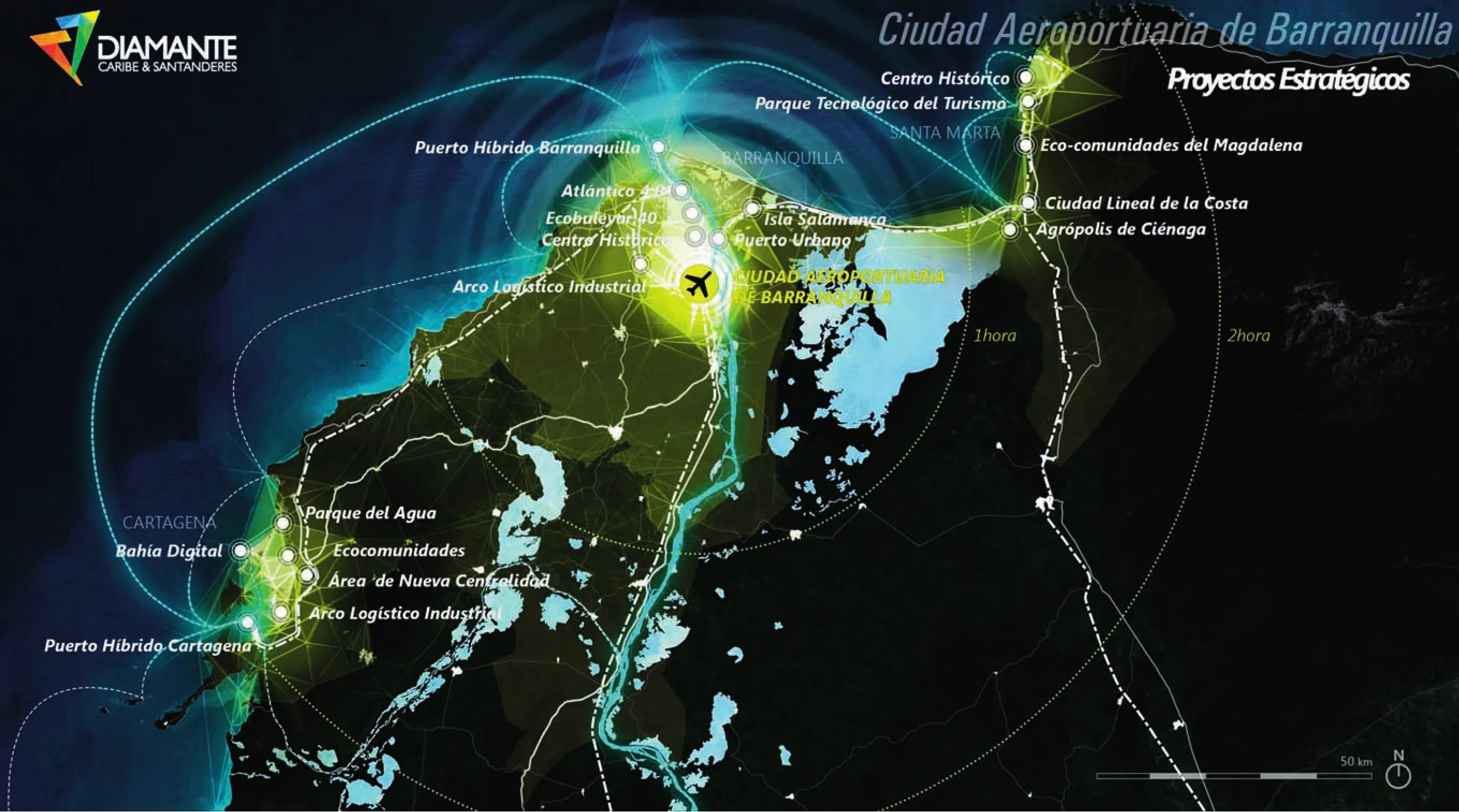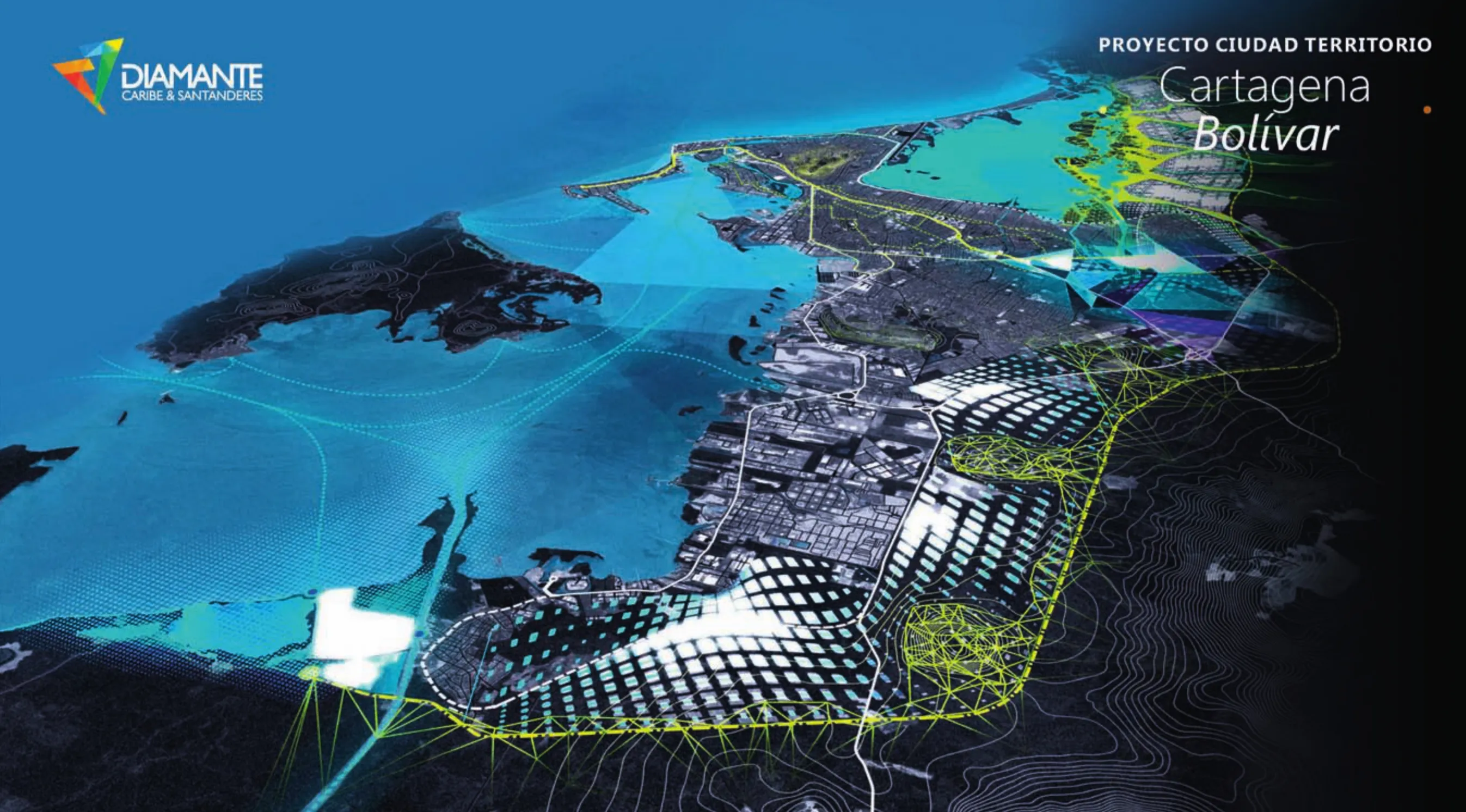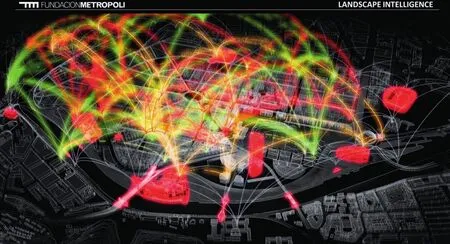Supercities·Landscape Intelligence
Alfonso Vegara

图7 / Figure 7生态大道Ecosystem Bulevar
1 Cities in a Global World
We live in a world of cities. Our planet is increasingly more urban. Cities are the new engines of the global economy, and at the same time they have the potential to be the main actors facing the challenges of climate change and the struggle against inequality and poverty. The ever greater interdependence between cities goes hand in hand with increasing physical and digital connectivity. The size of our cities is also changing, with traditional administrative boundaries becoming less and less relevant to the framing of responses to the major objectives of development, balance and environmental sustainability. If the past was shaped by periods in which the world was organized into empires and later into nation-states, in the future we will live more and more in a world of cities—a world of SuperCities(Figure 1—Figure 12).
The concept of Super-Intelligence, conceived as the combination between Human Intelligence and Artificial Intelligence, inspires our concept of SuperCities. Human Intelligence, when applied to cities, is interpreted as the values of leadership,vision, creativity, sensitivity, commitment, ethics and the ability to design a collective project for the future of the city. Artificial Intelligence allows us to use the advances of the technological revolution to serve the quality of life and the efficient functioning of cities in the future.
The human habitat has historically been conditioned by a series of crucial innovations that have changed the forms of living, the modes of production, social relations, political organization, the territory, and the city. With the invention of agriculture, once nomadic human groups became sedentary, and the first rural settlements and the first cities centered on trade emerged. The invention of the steam engine lies at the origin of the Industrial Revolution, which over the last two centuries has led to the progressive depopulation of the rural world, the rapid and widespread growth of cities, the emergence of capital and labor as differentiated factors of production and the birth of new social classes such as the bourgeoisie and the proletariat. Social differences were forcefully expressed in the contrast between the countryside and the city; and within the industrial city, in the segregation between the sophisticated bourgeoisie neighborhoods and the deprived working-class neighborhoods. Today we are going through a digital revolution that is once again radically transforming human settlements and our way of life.
At the start of the 21st century, we are experiencing one of the swiftest and most profound transformations in the history of humanity. Technological innovation—notably the development of telecommunications and the Internet—is fostering the emergence of a new international economic order that is reinforced by the progressive dissolution of trade barriers, the formation of great economic blocs, and the expansion of markets.

图8 / Figure 8巴兰基亚机场区,哥伦比亚Barranquilla Aeroport, Colombia
This unprecedented digital revolution lies at the confluence of four megatrends, namely cloud computing, mobile devices, social networks and the application of artificial intelligence to Big Data. We have never had so much computing capacity, such ease of access to information or so many options for physical and digital communication, and this is changing the way people live, work, have fun, learn and relate. It is also changing the traditional commercial function with the advent of e-commerce,the strengthening of logistics activities, especially last-mile activities, resulting in the need to reinvent traditional commercial spaces. Evidence of this fact lies in the current efforts in Singapore to reinvent Orchard Road, one of the most symbolic commercial axes in the world. It is also changing politics,the economy, our society and, of course, cities,which now enjoy opportunities that did not previously exist.
Globalization has brought important advances, but it has also opened up a “great fracture” between those countries, cities, enterprises and people that are integrated to this new economic order, and those that are not. The differences between rich and poor countries are today as deep as ever and cities, especially large cities in developing countries, are experiencing the contradictory effects of globalization with particular intensity.
The urban landscape of globalization is not only that of shining skyscrapers, luxury residential neighborhoods, private clubs and latest-generation airports, it is also the landscape of poverty and want. Large cities are places where business districts that drive the world economy coexist with the most atrocious poverty. We look at around at a landscape marked by growing social segregation,the disturbing presence of violence and insecurity,new barriers in the urban space, and private security systems in luxury gated communities, iconic buildings and malls. Today’s cities face ever greater challenges and the need to seek new forms of social cohesion, protection of our ecosystems and effective responses to the challenges of climate change.
The global economy continues to grow and is capable of generating a great deal of wealth, but the key issue is whether we are able to ensure that these advancements benefit everyone, and not just a small minority. The market economic system creates a framework that encourages private enterprise and the development of economic activities, promoting the generation of wealth. However, the market alone is incapable of overcoming the fracture of globalization. Effective responses to the challenge of creating a habitat that contributes to overcoming this fracture can be made at the scale of the city, at the local neighborhood scale and even in the structure of people’s day-to-day lives.
As a result, cities have a growing importance in our society and they function in a highly complex context, with undeniable challenges but with a range of opportunities that did not previously exist.

图9 / Figure 9巴兰基亚,哥伦比亚Barranquilla, Colombia
2 SuperCities and Territorial Diamonds
Our cities, with invariably limited economic resources, short terms of office and little political power, have to face formidable challenges. With these factors in mind, we have chosen to refer to this generation of singular places – whose leadership, creativity and shared vision are generating a special magnetism and developing initiatives and projects of great impact – as SuperCities.
These SuperCities are managing to discover the Intelligence of their Territories, what we know as Landscape Intelligence. They are the nodes of innovation and creativity of our planet. From the smallest rural settlement, by way of middle-sized towns and cities and Metrópolitan areas of all sizes, to the most complex urban mega-region we can imagine,each city and each territory can design an intelligent project for the future and develop effective actions to achieve relevance within this new global scenario of competition and cooperation, and of vital commitments to sustainability, to social integration and to the eradication of poverty. A new generation of SuperCities can be part of the solution to the great challenges facing humanity.
SuperCities have adapted to operate in an environment whose dimension is greater than the traditional municipal and Metrópolitan demarcations and in a more open context of physical and digital interrelations. They are developed on a new territorial and functional scale that fosters synergies and strategic complementarities. SuperCities are capable of articulating an intelligent dialogue with the systems of cities and ecosystems at their surroundings as a frame of reference in which to discover their key opportunities and their future vocation, forming what can be referred to as Territorial Diamonds.
Territorial Diamonds are defined by their important economic agglomerations, linked to the concentration of advanced tertiary functions, global communication infrastructures, in addition to training and knowledge centres. They integrate poly-centric urban systems, Metrópolitan areas, medium and small cities, as well as rural systems to constitute a territory capable of hosting an array of complementary activities. The Diamond’s nodes of special urban intensity are crucial to the allocation of the most advanced economic sectors. At the same time,these areas can promote territorial balance strategies and counter poverty.

图10 / Figure 10卡拉豆钻石,哥伦比拉Carabean Diamond, Colombia
A Territorial Diamond presents a wide variety of opportunities to expand economic development and increase the dimension of regional productive clusters. They also generate sectorial and territorial interaction; fostering integrated economic, social,and environmental strategies. To define the future of these Territorial Diamonds, we need complex interinstitutional participation and collaboration strategies that cross traditional political and administrative boundaries. It is important to define an integrated global vision and strategic projects that can catalyse change. The improvement of physical and digital connectivity is essential to articulate these territories.
This effort to seek strategic complementarity provides these territories with a new dimension. New transportation networks, airports, regional transit systems and logistic platforms improve mobility and strengthen economic links among the different activity nodes. This creates a networked urban structure that can benefit from a new generation of digital platforms. Cities, as has been repeatedly pointed out, are the activation node for the territory’s economic and social activities. SuperCities,the cities of the future, in order to be relevant in the global society, will have to be organised in such poly-centric structures of synergistic and complementary nodes.
SuperCities, irrespective of their size or current level of development, are territories that strive for excellence and embrace the commitment to contribute from their field of action to transform the world and serve as a reference to other cities. They are capable of understanding their own identity and their components of excellence as a basis to define their urban profile, activating their networks of cooperation, and developing their own city project.SuperCities are becoming the nodes of social and economic activation, in places whose special magnetism serves to attract talent and innovative initiatives. They are the magical places where the Landscape Intelligence is expressed in all its plenitude.They are the spaces of social and cultural creativity par excellence. Science, art and technological innovation, as well as social transformation and advancement in quality of life, emerge more easily in cities.
3 Designing the Cities of Tomorrow
When designing the cities of the future, we must consider three key aspects.
The first of these aspects is the fight against climate change. This means considering the ecological dimension of the urban, a sensitive dialogue with the natural environment and the responsible use of natural resources. Many cities have introduced programs of energy efficiency, the use of renewable energies and sustainable urban mobility, striving for a progressive reduction of polluting emissions.
The fight against climate change is transforming the urban agenda in many innovative cities and has allowed sustainable urbanism to evolve towards a better understanding of the urban metabolism, making resilience a core objective, and integrating the health of the urban system and their inhabitants.
The second key aspect is the need for a profound and progressive improvement of the governance of the territory. Governance acquires a strategic dimension in today’s cities. Innovation is apparent in the models of government of cities, as well as in the planning and management instruments. The reduction of inequality, which is one of the challenges facing our society, is not solely dependent on macro-economic factors. Local government systems can foster advances in democracy and social reform in an ongoing process of reconciling the private enterprise and the public good. This is what various authors have called ethical or moral capitalism, an approach that, in our point of view, may find surprising answers for the work in cities.
The third is the digital society, not only under the initiatives of the smart city or the use of digital technology to substantially improve the efficiency of urban services, but as an integral development of the knowledge society. This includes the extraordinary potential of education, science and technology to stimulate local talent and for the creation of ecosystems of innovation in cities.
In recent years, much has been written and debated on competition among cities. It has been frequently pointed out that States are not the truly operational and relevant economic units in the new economy,but rather cities and their regional environments.
The key issue for city governments is knowing if mayors and municipal or regional government teams can do something to improve the competitive capacity of enterprises within their municipality or region, or if in reality, these territories are perceived as competitive because the enterprises that have settled there are.
In our research at Fundación Metrópoli it is proven that cities and regions can develop certain competitive advantages for certain activities. Cities and territories can achieve this with a bureaucratic simplification, an agile and efficient management of the public sector, with education facilities that are adequate for their enterprise profile, with quality infrastructure and digital applications, with well-connected airports, advanced logistical services, financial services, efficient mobility, available land at a reasonable price, quality public spaces,etc., but especially, a city can provide competitive advantages if they stimulate the development of local economic clusters, or a specific composition of activities and appropriate services for the inception and installation of enterprises and professionals of a certain profile. Thus, cities need to foster unique and intelligent local profiles.

图12 / Figure 12智慧景观Landscape Intelligence
Most definitely, urban policy is an essential factor for the creation of an economic prosperity and a sustainable quality of life in cities. One of the main and most difficult missions of local governments is to point the city model towards a smart direction,one that is inspired in the specific idiosyncrasies of the locality, in its specific components of excellence, and with an important participation of its various actors. Local governments, which sometimes have short terms of office, must identify those critical projects for which the city wants to bet and dedicate the required energy, excitement and leadership to move in that direction.
4 Towards a City Project
There is a basic distinction between cities, aside from their size, level of economic development or urban profile. There are cities with a project, and cities without a project. Intelligent Landscapes are places capable of equipping themselves with a project and to find a balance between economic strategy, cohesion and social development, and sensibility and care for the natural environment.Intelligent Landscapes are characterized by having an innovative City Project, based on the vocation of the territory, with a solid social support and in correspondence with the strategic options of economic development. Sustainability is conceived from a broad perspective that includes environmental sustainability but also economic, social and cultural sustainability. It is a concept of sustainability that evolves with the idea of urban resilience, and the ability of cities to adapt to change, to face new challenges, and to solve crisis or risk situations.
21st century urbanism is not a zero-sum game.The mere municipal budget management has very limited effects on the transformation potential of the city. With a City project, with leadership and collaboration capacity among the different actors of the city, the possibilities for the future are multiplied exponentially.
Cities that are most successful in the future will be those that achieve an intelligent balance between the different components of the urban trilogy: economic competitiveness, social cohesion and environmental sustainability. Within an economy that is based on knowledge, innovation and intellectual capital, the factors of competitiveness are not purely economic, but depend on the social equilibrium and the environmental quality. In the future, large,medium or small cities will be able to create value by highlighting their identity and strengthening their global connections. The habitats of globalization must be reinvented, being aware that the most attractive cities and territories, those capable of exercising magnetism over their environment and of offering quality of life to their citizens, will be those with a project of an exciting and shared future and not only those that already enjoy consolidated departure conditions.
- 城市设计的其它文章
- Urban Micro Scale Tools:A method to Measure the Relationship Between Private and Public Space
- Urban Design Under the Influence of Government Reform: Away from Urban and Rural Planning Management?
- ICE Kraków Congress Centre, Krakow,Poland
- G6连连看—城市翻修系列设计课程教学报告(36)之北京G6京藏高速连接设计
- TEXTS TRANSLATED FROM CHINESE
- 万能视角建筑学(四)之术语表

